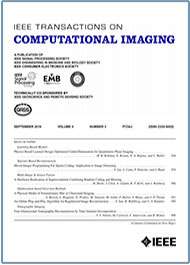Reduced-Space Relevance Vector Machine for Adaptive Electrical Capacitance Volume Tomography
Top Reasons to Join SPS Today!
1. IEEE Signal Processing Magazine
2. Signal Processing Digital Library*
3. Inside Signal Processing Newsletter
4. SPS Resource Center
5. Career advancement & recognition
6. Discounts on conferences and publications
7. Professional networking
8. Communities for students, young professionals, and women
9. Volunteer opportunities
10. Coming soon! PDH/CEU credits
Click here to learn more.
Reduced-Space Relevance Vector Machine for Adaptive Electrical Capacitance Volume Tomography
We introduce an efficient synthetic electrode selection strategy for use in Adaptive Electrical Capacitance Volume Tomography (AECVT). The proposed strategy is based on the Adaptive Relevance Vector Machine (ARVM) method and allows to successively obtain synthetic electrode configurations that yield the most decrease in the image reconstruction uncertainty for the spatial distribution of the permittivity in the region of interest. The problem is first formulated as an instance of the Quadratic Unconstrained Binary Optimization (QUBO). By noting that the QUBO formulation is an NP-hard problem and thus prohibitive in practice, we then introduce the Reduced ARVM method, corresponding to the application of the ARVM method to a reduced search space. By using the Reduced ARVM method, good image reconstruction and low uncertainty levels can be achieved in AECVT with considerably fewer measurements. To corroborate our analysis, we present simulation results for three representative AECVT scenarios.
Electrical Capacitance Volume Tomography (ECVT) [1] is a process tomography modality used for reconstructing the electric permittivity distribution in a region of interest (RoI) from a set of capacitance measurements. The latter are obtained from the mutual capacitances between electrode plates placed around the RoI. ECVT has been successfully used in the imaging and characterization of numerous multi-phase flows, with application in a wide range of research and industrial processes [1]–[2][3][4][5]. A step forward in the ECVT progress has been Adaptive Electrical Capacitance Volume Tomography (AECVT) [6], [7], which comprises a series of modifications to the original ECVT sensor toward achieving higher flexibility in the measurement process. These modifications include the use of smaller electrode plate segments that can be electronically configured to form synthetic electrodes of different shapes and sizes. This enables, for example, a fine-stepped scanning of the RoI while meeting minimum (synthetic) electrode area constraints as set by the required signal to noise ratio (SNR) [7], as depicted in Fig. 1(a). By synthetic electrodes we mean here those that are formed by an electronic combination of small (physical) electrode segments, as indicated by the colored dashed lines in Fig. 1. The effectiveness and applicability of AECVT has been illustrated by multiple recent works [7]–[8][9].
SPS Social Media
- IEEE SPS Facebook Page https://www.facebook.com/ieeeSPS
- IEEE SPS X Page https://x.com/IEEEsps
- IEEE SPS Instagram Page https://www.instagram.com/ieeesps/?hl=en
- IEEE SPS LinkedIn Page https://www.linkedin.com/company/ieeesps/
- IEEE SPS YouTube Channel https://www.youtube.com/ieeeSPS












